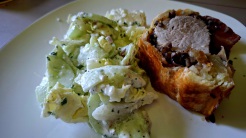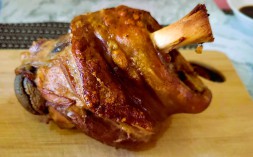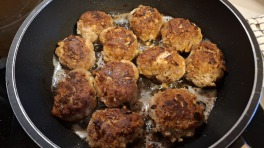Pork Fillet - Bacon - Mushrooms in Puff Pastry, Roast Pork with Crust, Pork Knuckle, Meat Balls or Meat Patties
- Swabian Spaetzle*, Cheese Spaetzle*, Lentil and Spaetzle* with Vienna Sausages, Pork Fillet with Spaetzle* and Mushroom Cream Sauce
- Filled Pasta Cases, "Schupfnudeln" with Sauerkraut and Bacon, Swabian Mince Meat Sauce
- Beef Roulades, Beef Goulash, Swabian Onion Roast Beef
- Pork Fillet - Bacon - Mushrooms in Puff Pastry, Roast Pork with Crust, Pork Knuckle, Meat Balls or Meat Patties, Smoked Pork Neck
- Swiss Sausage Salad, Pasta Salad, Potato Salad
- Pasta Bake, Onion Cake
- Liver Dumpling Soup, Pancakes (Soup), Sour Tribe Soup, Chicken Soup
- Fish - Pikeperch Fillet, Fish – Trout “Müllerin Art"
- Bee String Cake, Bavarian Plum Cake, Swabian Apple Tart, Blake Forest Cake
*home made South German Noodles
Pork tenderloin and mushrooms in puff pastry: A juicy pork tenderloin wrapped in chopped mushrooms and bacon in puff pastry—not just for the holidays.
Ingredients:
- 1x pork tenderloin, approx. 600g
- 1x puff pastry, baking sheet
- 1x large onion
- 8x bacon slices
- 300g brown mushrooms
- Salt
- Pepper
- Mustard
- Egg yolk
- 1x tablespoon milk
Preparation:
Chop the mushrooms, dice the onions, and fry them together in a pan, seasoning with salt and pepper until all the water has evaporated. Season the tenderloin with salt and pepper, brush with mustard, and sear. Roll out the puff pastry and cover with bacon. Spread the mushroom and onion mixture over the bacon (you may need to strain the mushrooms again if there's too much liquid), and place the fillet in the center.
Roll it in puff pastry and place it seam-down on a baking sheet lined with parchment paper. Whisk the egg with the milk and brush it over the bacon.
Bake for 30 minutes at 200°C (400°F) (after 15 minutes, increase to 160°C), fan-assisted oven, then let it cool for another 5 minutes.
Roast Pork with Crust: No Bavarian inn is complete without a roast pork or roast with crust. While in Württemberg, roast pork tends to be prepared without a crispy crust, Bavarian roast pork is always served with a crust. I use shoulder meat for the roast pork; if you like it really juicy and even more crust, you should use a whole piece of pork belly. The highlight is the roasting sauce; I don't use red wine here, but rather a dark export beer.
Ingredients:
- 1.5 kg pork shoulder with rind (1.5 kg pork belly)
- 2 large onions
- 2 cloves garlic
- 1 bunch soup vegetables
- 2 large onions
- 1.5 l broth (beef or vegetable)
- 1 tbsp tomato paste
- 1 tsp medium-hot mustard
- 500 ml dark beer
- Sauce thickener or cornstarch
- 2 bay leaves
- 1 tsp sweet paprika
- Salt and pepper
Preparation:
Roughly chop the vegetables and onions and sauté in a large pot with the finely chopped garlic, mustard, and tomato paste. Deglaze with the broth, add the bay leaves, and bring to a boil. Rub the pork roast with pepper, salt, and paprika and add it to the pot. Simmer gently over low heat for at least 1 hour. Preheat the oven to 160°C (fan oven).
Prepare a large roasting pan. After 1 hour, remove the pork roast from the broth and set aside on a cutting board. Filter the vegetables from the broth using a sieve and arrange them in the roasting pan.
Carefully cut diamond-shaped cuts in the rind with a sharp knife (only the rind, not all the way to the meat). Place the broth on top of the vegetables. Pour the broth into the roasting pan until it reaches about 1.5 cm below the rind. Place the roast in the oven for about 70 minutes, basting with broth and dark beer every 10 minutes. Now heat the oven to 180 degrees and leave the roast in the oven for another 20 minutes, then pour over the stock and beer again.
Remove the roast from the oven and set aside on a cutting board. Strain the liquid from the roasting pan through a sieve into a saucepan. Season to taste, bring to a boil, and thicken with gravy thickener to your desired consistency. Finally, stir in a large knob of butter.
Slice the roast, add gravy, and serve with your choice of side dish.
Pork knuckle: The king of Bavaria. The pork knuckle is the end of the pork leg, just above the knuckle and below the meaty ham. Preparation varies regionally, but there are two main variations: While in northern Germany it is pre-cured and then boiled, in southern Germany it is usually roasted or grilled unsalted, which transforms the rind into a crispy crust. The result of this preparation is called “Haxe”, while “Eisbein” always refers to the boiled version.
Ingredients:
- 1.5 kg pork knuckle
- 2 green onions
- 1 bunch of soup vegetables
- Salt
- Pepper
- 1.5 l broth (meat or vegetable)
Preparation: Roughly chop the vegetables and onions and sauté in a large pot, deglaze with the broth, and bring to a boil. Rub the pork knuckle with pepper and salt and add it to the pot. Simmer gently over low heat for at least 1 hour. Preheat the oven to 200°C (fan oven).
Remove the pork knuckle and carefully score the rind into diamond-shaped shapes (only the rind, not all the way to the meat).
Transfer the stock (with the vegetables) to a large roasting pan and place it in the center of the oven's lowest oven rack. Place the pork knuckle on the grill above the roasting pan.
Bake the knuckle for 1 hour, basting the stock every 10 minutes with a ladle (dark beer is often used in Bavaria). If necessary, grill for the last 5-10 minutes (if the crust isn't crispy yet).
Remove the knuckle and let it rest on a wooden board for 5 minutes. Meanwhile, pour the stock through a sieve into a saucepan, bring to a boil, and season to taste.
Sauerkraut and potato or bread dumplings go wonderfully with this dish.
Meatballs: This dish is highly appreciated both hot and cold. Of course, there are many regional variations, starting with the meat used – veal, beef, pork, etc. I prefer mixed minced pork and beef.
Ingredients:
- 500g mixed minced meat (beef & pork)
- 1 large onion
- 1.5 tbsp medium-hot mustard
- 1 egg (L)
- 1 cup breadcrumbs (breadcrumbs, breadcrumbs - alternatively, 1 stale roll, softened in water and squeezed dry – makes the Meatballs a little fluffier)
- Salt and pepper
- Clarified butter or rapeseed oil
Preparation: Place the ground meat in a large bowl, dice the onion very finely, and add it to the ground meat. Add mustard, egg, salt, and pepper. Finally, add the breadcrumbs to the bowl.
Knead the mixture thoroughly with moistened hands and then let it rest for about 30 minutes.
Once the resting time is up, form balls with moistened hands. I don't make meatballs that large, about 80-90 grams each. Place the finished balls on a lightly floured board until they're all formed. Heat clarified butter or rapeseed oil in a large nonstick pan over medium heat. Place the balls in the pan and flatten slightly. Fry on both sides until they have a nice brown color and the surface is slightly crispy.
Potato salad, pasta salad, or boiled potatoes make excellent side dishes.
Smoked Pork Neck (also known as Kassler Roast)
"Smoked pork neck" is a cut of pork (usually from the neck/shoulder) that is cured and then hot- or cold-smoked. Smoked pork neck is flavorful and juicy and is usually served with sauerkraut and boiled potatoes. I sometimes make hearty gravy from the cooking liquid and then serve the smoked pork neck with spaetzle.
Ingredients:
- 1-1.5 kg smoked pork neck (also known as Kassler or cured pork)
- 1-2 large onions
- 1 bunch of soup vegetables (carrots, leeks, celery)
- 1.5 l broth (meat or vegetable)
- 2 bay leaves
- Pepper (no salt initially, as the meat is cured; you can always add more later)
- Parsley
- 2 tbsp rapeseed oil
Preparation:
Cut the onions and soup vegetables into large pieces and sauté them well in a large pot with the rapeseed oil. Add the stock and bay leaves and bring to a boil (approx. 5 min). Reduce the heat. Rinse the smoked pork neck thoroughly with cold water and pat dry. Once the liquid has stopped simmering, add the pork neck and let it steep in the simmering liquid for 1.5 to 2 hours (depending on size). Remove the meat from the liquid, slice it, and serve with your chosen side dishes.
Source Pictures: own works, H. Rufer






